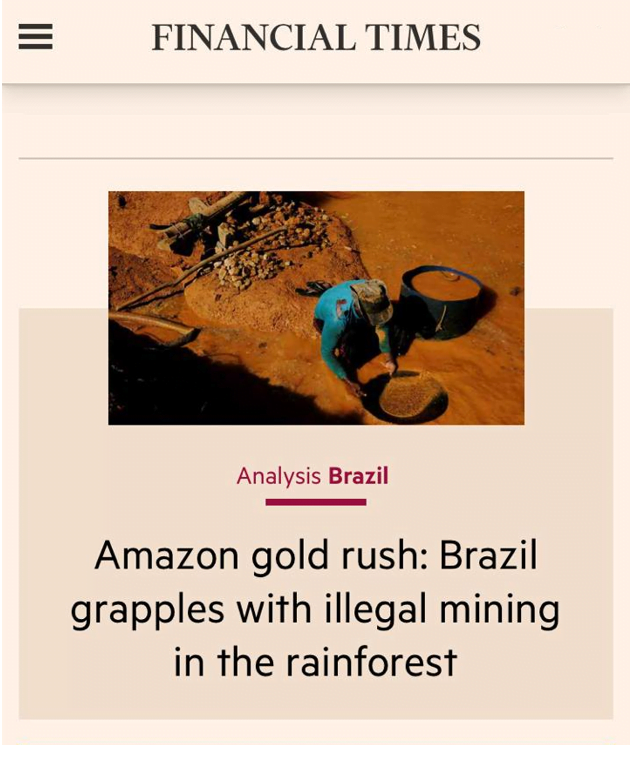O Financial Times traz intensa investigação sobre o garimpo ilegal na Amazônia.
Os bastidores da extração do ouro ilegal, a eterna cobiça pelo metal precioso, a contaminação de rios pelos mercúrio, a disparada do preço do ouro nos mercados internacionais – motivada pela pandemia e pela crise econômica – e como o mercado financeiro age em transações que desconhecem a origem do ouro.
O jornal traz dados dos trabalhos que o Escolhas vem desenvolvendo sobre o garimpo ilegal na Amazônia. Em entrevista ao jornalista Bryan Harris, a gerente de Projetos do Escolhas, Larissa Rodrigues explica a ausência de rastreamento e de controle da comercialização do ouro e sobre como o ouro do garimpo ilegal chega facilmente aos mercados internacionais de forma legalizada. ” O processo é simples. “Um cara tem ouro na mão, mas não tem documentação — porque muitos extraíram ouro de lugares que não são legais”, diz Vasconcelos. “Quando ele vem vender esse ouro, ou ele apresenta um documento falso, ou a própria loja de compras produz o documento. “Nesse momento, o ouro é comprado por um negócio oficial, que declara que veio de uma mina legítima”, acrescenta. “Então o ouro entra no sistema como se fosse legal. Foi ‘aquecido’.”
Para saber mais, acesse: www.escolhas.org/amazoniasemgarimpo/
Confira abaixo a matéria na íntegra:
“Amazon gold rush: Brazil grapples with illegal mining in the rainforest”
When Brazilian military helicopters swooped over the Maicuru Biological Reserve in the Amazonian state of Pará in October, they discovered an illegal mining operation that was surprising in its sophistication. There was a system of motors to heave gold out of deep caverns where it had been found and landing strips carved out of the surrounding rainforest to take the cargo away.
“This location is only accessible via plane, there’s no other way. So to structure an operation there, first you need to build an airstrip, and then have aeroplanes,” says Gecivaldo Vasconcelos, the federal police chief of Santarém, a sweltering port town along the banks of the river. “This demands an investment, it is not small scale.”
In the 1980s, towards the end of Brazil’s military dictatorship, the Amazon witnessed a ferocious gold rush that attracted thousands of poor people who dug for the metal with shovels in a vast open pit. The medieval scenes of brutality from the wildcat mining and the wanton destruction left in their wake shocked the world at a time when the fate of the Amazon rainforest was first becoming a global issue of concern.
In the 1980s, towards the end of Brazil’s military dictatorship, the Amazon witnessed a ferocious gold rush that attracted thousands of poor people who dug for the metal with shovels in a vast open pit. The medieval scenes of brutality from the wildcat mining and the wanton destruction left in their wake shocked the world at a time when the fate of the Amazon rainforest was first becoming a global issue of concern.
Three decades later, illegal miners are once again flocking to the Amazon with the same get-rich-quick culture. But this time they are also bringing new heavy machinery and financial knowhow.
As the price of the precious metal has soared during the coronavirus crisis, so too has production in the Amazon. Much of the gold is exported, mostly to western nations, including the UK, US and Canada.
Large swaths of supposedly protected lands are being razed to make way for modern equipment to extract the metal. An area of rainforest equivalent to the size of more than 10,000 football pitches was destroyed last year by illegal wildcat miners alone, according to Ibama, the federal environmental protection group, an increase of 23 per cent over 2018. This is part of a broader surge in deforestation in the Amazon region.
To process the gold, the miners use mercury, which then seeps into the air and rivers, contaminating local produce and affecting local communities, some of whom complain about a spate of frightening illnesses, including an increase in women miscarrying, according to federal prosecutors.
With illegal mining also comes violence. Several indigenous tribes in the Brazilian Amazon, including the Munduruku and Yanomami, are under constant threat from miners that are often armed and sometimes working for organised crime rings.
Murders are common, say the police. Nor is the violence contained by national borders. The federal police say that the criminal groups at work in Brazil have close connections with Venezuela, where a mining region in the south of the country is dominated by organised crime and forced labour is common, according to the UN and several non-governmental agencies.
Much of this “conflict gold” is spirited out of Venezuela via Colombia, but a lot is also smuggled into the Brazilian Amazon, where it can be easily laundered, sold and eventually exported globally from São Paulo.
“The risk from illegal gold is that the proceeds can be used to promote more illegalities, including drug and arms trafficking and even terrorism. If we don’t address this problem, we will lose this war,” says Eduardo Leão, director of the National Mining Agency.
Brazilian police have in recent weeks launched a string of operations, aimed at rooting out illegal miners, the cross-border smuggling routes and the laundering services that allow illegal gold to enter the global financial system.
The raid in the Maicuru reserve, a joint military-police operation which concluded with the police blowing up the airstrip, was one of a string by authorities in the Amazon. Days earlier, 60 federal police served 18 warrants against members of a cross-border “criminal organisation”, which the authorities allege was smuggling tens of millions of dollars in gold and cash between Venezuela, Brazil and Guyana.
But as the police battle begins to heat up, a victory for law enforcement looks far from certain. “There is an absence of law, of regulation,” says Paulo de Tarso, a federal prosecutor in Santarém. “Our work is like trying to stop ice from melting.”
VER ÍNTEGRA EM: INSTITUTO ESCOLHAS





